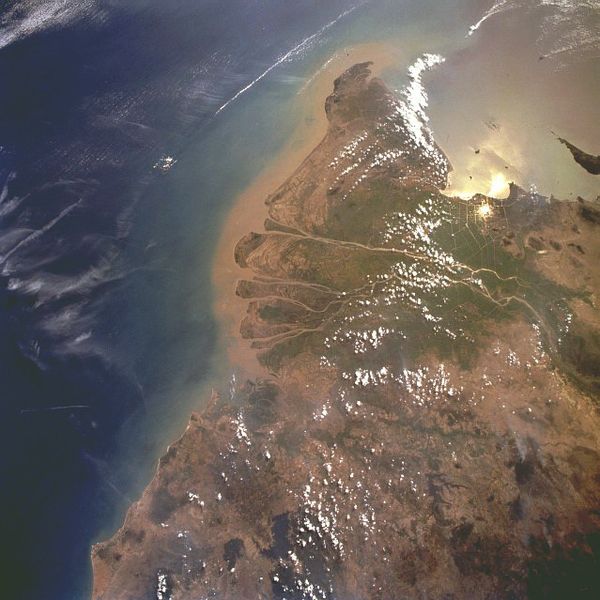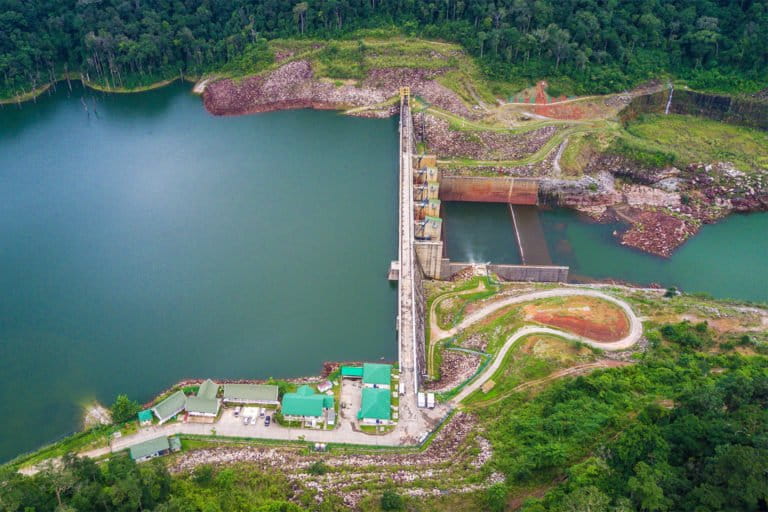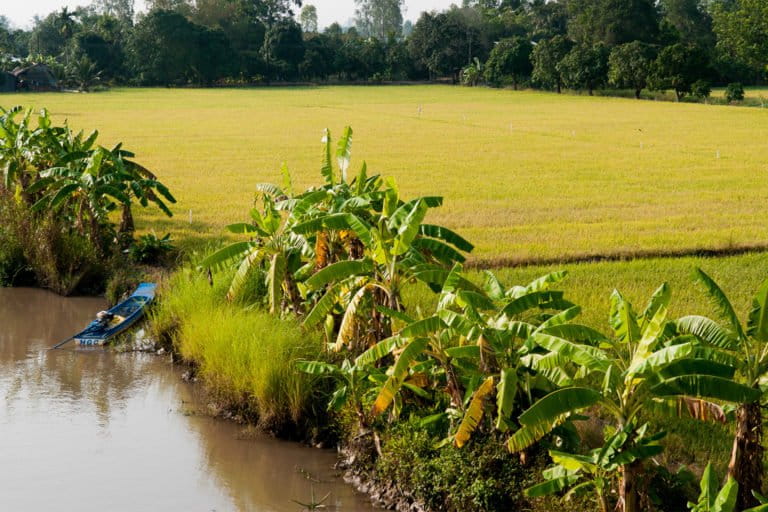- The increasing salinity in Mekong Delta is currently being driven by the building of dams upstream and sand mining downstream, but climate change will likely be the predominant factor by 2050, a new study shows.
- The Mekong Delta is a key farming region, and already more frequent and extensive saltwater intrusion is killing off large swaths of crops with greater frequency.
- The study’s authors say regional stakeholders need to address the anthropogenic drivers of saltwater intrusion in the delta now, before climate change makes it a global problem.
- The study also has implications for other delta systems across Asia, which face similar pressures, both anthropogenic and climate change-driven.
A new study has identified 2050 as the tipping point by which stakeholders in the Mekong Delta will no longer be able to mitigate the issue of saltwater intrusion, which has already devastated agriculture in parts of Vietnam’s leading rice-producing region.
The study, led by Sepehr Eslami, a senior researcher and adviser at Deltares, a Dutch consultancy, argues that the biggest causes behind the issue are currently anthropogenic, but by 2050 climate change will likely play the bigger role, putting the issue into the hands of global cooperation.

In effect, it puts a new deadline on mitigation on the ground in the Mekong Basin, while also providing the data needed for leaders to move forward and meet this deadline.
It also has implications on a broader scale for other deltas, particularly in Asia, providing key principles for delta scientists to rethink research in areas that are facing similar issues.
A breakthrough for delta research
The study comes as the culmination of 12 years of research within Rise and Fall, a project at Utrecht University in the Netherlands and Deltares, Eslami says.
Two earlier papers authored under the project established, for the first time, a conclusive causal link between anthropogenic sediment starvation — which is when sediment that would normally float downstream is blocked — and saltwater intrusion.
Prior to that, despite early warnings in the early 21st century, extreme salt intrusion was most commonly linked to sea level rise and climate change.
Eslami authored one of these papers in 2019, which showed that in the past 20 years, climate change had accounted for less than 5% of the challenges facing the Mekong Delta, and tied the issue of increasing salinity to sediment starvation due to both upstream hydropower development and downstream sand mining.

There are 11 existing hydropower dams in China, two in Laos, and at least 300 on tributary waterways upstream in the Mekong Basin. These divide the river into reservoirs and effectively block the flow of river sediment downstream, which changes the shape and depth of the riverbed.
According to Marc Goichot, a senior adviser with WWF focusing on freshwater issues in Asia Pacific, these dams are retaining most of the sediment in the Mekong River — as much as 50% to 60%.
Sand mining exacerbates the problem, digging incisions into the riverbed. Done largely to fuel urban development, the practice removes 50 million to 100 million metric tons of sand from the river every year, according to Eslami.
As a result of these factors, Mekong riverbeds are deepening by a reported 200-300 millimeters (8-12 inches) per year.
This is allowing seawater, which naturally flushes in and out of the delta, to intrude deeper and stay for longer, at high concentrations.
The dams also interrupt the flow of fresh water downstream which in turn interrupts the process of flushing seawater out.
Research shows that while climate change does pose grave natural hazards to the delta in the coming decades, these anthropogenic factors are having a far more urgent impact in the short term.
Eslami’s current study maps projections for these anthropogenic drivers as well as climate change up to the year 2050, combining all major factors into one big picture and showing that by 2050, climate change will be a much larger problem.
“The thing about climate change … is that you need the global community to work together to manage [it],” he said, “and no one says regional cooperation is easy but it’s definitely less of a challenge than global cooperation.”
If stakeholders don’t intervene now to address the anthropogenic forces behind the destruction of an entire region, they may miss their chance.

A real-time impact
The impact of seawater intrusion has already been devastating for parts of the Mekong Delta, particularly since so much of its population lives off the land.
Farmers are seeing entire crops or ponds full of produce fail because of limited fresh water, putting their livelihoods into serious question.
The issue was brought to a head in 2019 and extending into 2020, when a serious drought hit during an alarming period of prolonged salinity, pushing farmers into desperate situations.
In Ben Tre, a province that traditionally does not see much saline intrusion, salt levels were high enough to kill entire fields of trees.
Ben Tre fruit farmer Vo Thanh Soi says he can no longer grow the fruit he has nurtured for generations because of the impact salt had on his crops that year.
“All my crops including durian and rambutan died. I could not save a single one,” he said by phone.

According to his nephew, Quoc Anh, who lives on another farm in Ben Tre, households had to buy water for home use and irrigation, depending on their crops.
“Each day, one household needed about 5,000 liters [1,320 gallons] of water for irrigation,” he said. The daily cost for this much water, and for delivering it, was the equivalent of up to $43, according to Quoc Anh.
Not knowing that the water they were bathing in was saline, many people developed skin conditions, he remembers.
Luckily for Quoc Anh, his farm survived because his family had been able to prepare for the situation. But the farms around his lost their crops and the plants that did survive were damaged. This even caused bankruptcy for some households if they lost their whole garden, he says.
Another Ben Tre resident, Huynh Khac Vinh, was also hit by 2020’s salt drought, but because the trees his family had planted were perennial, he didn’t lose the whole crop.
“[These] trees have strong and deep roots so they can live for a while, maybe up to a year,” he said. Shorter-term crops, like rice, will die.

Vinh’s family only bought enough fresh water to drink and shower with: two months’ worth, for the equivalent of around $17.
In the past year, Vinh says, saline intrusion hasn’t been as bad. The monsoon was forecast to fall late again, but the rains came early so there was plenty of fresh water.
This is to be expected — salinity levels naturally fluctuate year to year in the Mekong Delta — but scientists have observed an overall upward trend in severity, Eslami says.
Added to this, drought events like the one that hit in 2019 are expected to be more frequent, occurring twice as regularly as in the past.


Trans-regional collaboration needed
One of the significant aspects of Eslami’s study is that it provides clear findings that can inform mitigation to avoid this outcome, if stakeholders act now.
To make the changes that are necessary there would need to be effective regional collaboration and diplomacy.
“It’s a lot of communication [and] finding common ground … towards a direction where all the countries keep the resources of the delta as trans-boundary assets,” Eslami said. “Those resources [are] not only water but also sediment because rivers consist of water and sediment.”
In this way, countries could translate issues that they all individually face into common challenges that can be tackled together.
There has been some progress in regional discourse about the issues facing the delta, although debate continues, Eslami says.
In September 2020, the United States agreed to provide at least $153 million to Mekong countries to fund collaboration in the region.
Last month, the Mekong River Commission (MRC) urged its member states, and China, to share more data on hydropower operations.
But the MRC does not currently have any provision for the equitable trans-regional management of river sediment, according to WWF’s Goichot.
“[The MRC] was set up to address an issue of water quantity … and the procedures are around this,” he said. “It’s the wrong tool in the box. It’s like you’re holding your hammer when you need a screwdriver.”
Within Vietnam there is ongoing progress to adapt to the issues facing the Mekong Delta, largely under Resolution 120, a 2017 agreement on the “Sustainable and Climate-Resilient Development of the Mekong Delta.”
A conference was held in March this year to assess the resolution’s implementation so far and make recommendations for how to move forward.
The issue is also well-discussed among local Mekong Delta communities.
Vo Thanh Soi, the farmer, estimates that about 70% of the people living in his community are aware of the impact of the upstream dams on the Mekong Delta. He has seen the change himself, he says. In recent years there has been little sign of the fierce floods he saw as a young man. People are also well aware of sand mining.

Farmers are adapting in their own ways to the salinity, he says. Soi has converted his own farm to green-skinned pomelo and kumquat trees as they can cope with mild salinity.
Vinh says he’s confident that the Mekong Delta will be able to continue to adapt. Vietnam has a regionally recognized voice on climate change, he says, and a good track record on diplomacy.
“In addition to diplomacy, we can change the structure of the economy so that we don’t depend on farming anymore, and those who still farm can plant perennial trees,” Vinh said. “We could end up driving so many good economic results in this way.”
Many people are already diversifying. Quoc Anh is seeking out a new livelihood as an emcee and has opened a business selling groceries from Japan, while still working on his farm.
Others, though, say the thought of working another job is deeply saddening.
“Every morning, the farmer visits his farm, walks around his farm for a while and then he can come home in satisfaction,” Soi said.
If this were to end, he says, his life would be turned upside down.

Not just the Mekong
Eslami’s study indicates that the window of opportunity for mitigating the issues in the Mekong Delta is closing much faster than the general perception.
The issue involves multiple drivers and the time to act is now.
But what does this mean in the context of other deltas, particularly those in Asia?
According to Goichot, “all deltas were formed according to similar natural processes and are affected by the same types of human activities, thus there is a fair chance that [the study’s] findings would apply.”
This is particularly true for Asia’s mega deltas because they all suffer from similar human drivers as well as climate change, Eslami says.
“So a similar approach or similar work has to be done for all of these deltas to be able to actually understand how exactly a foreseeable future looks for [them].”
A study of this scale has never been done in Asia.
Eslami’s current study serves as a reference from which to set up research methodology for projects in other mega deltas across Asia, a region that is hugely significant to the rest of the world.

These deltas are known to collectively contribute 75% of the world’s sediment discharge from land to ocean. They are also home to a huge percentage of the world’s population, and they are a significant source of agricultural produce. Eighty percent of the world’s total area of rice paddies is in Asia, and mostly in deltaic lowlands.
But further research is key. The study’s relevance to other deltas needs to be verified with firsthand measurements and analysis, Goichot says.
For now, the study’s greatest application is on the ground in Vietnam, where mitigation of the issues facing the Mekong Delta is both urgent and a top priority.
With the findings and methodology that the study provides, stakeholders can now tackle the problem head-on.
Citations:
Eslami, S., Hoekstra, P., Nguyen Trung, N., Ahmed Kantoush, S., Van Binh, D., Duc Dung, D., … van der Vegt, M. (2019). Tidal amplification and salt intrusion in the Mekong delta driven by anthropogenic sediment starvation. Scientific Reports, 9(1). doi:10.1038/s41598-019-55018-9
Eslami, S., Hoekstra, P., Minderhoud, P. S., Trung, N. N., Hoch, J. M., Sutanudjaja, E. H., … Van der Vegt, M. (2021). Projections of salt intrusion in a mega-delta under climatic and anthropogenic stressors. Communications Earth & Environment, 2(1). doi:10.1038/s43247-021-00208-5
Banner image of Mekong Delta in Vietnam by LisArt via Flickr (CC BY-NC-ND 2.0).
